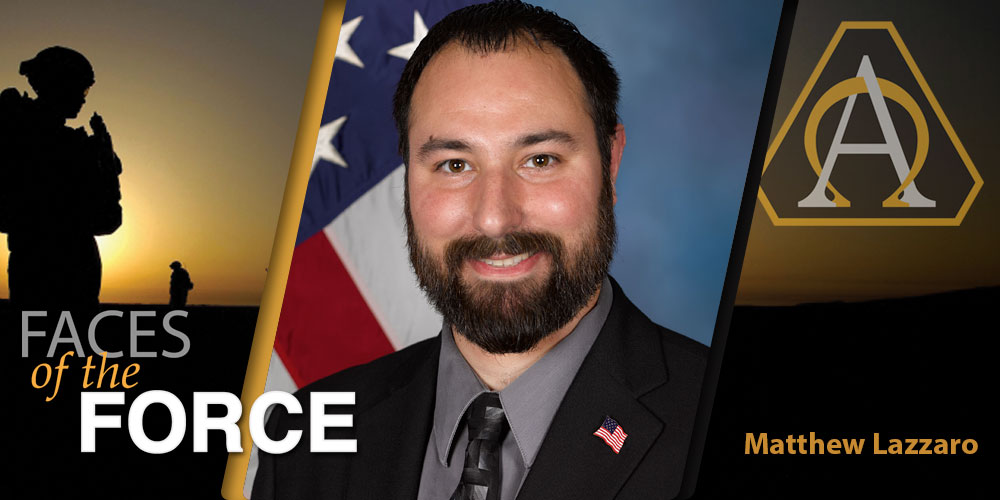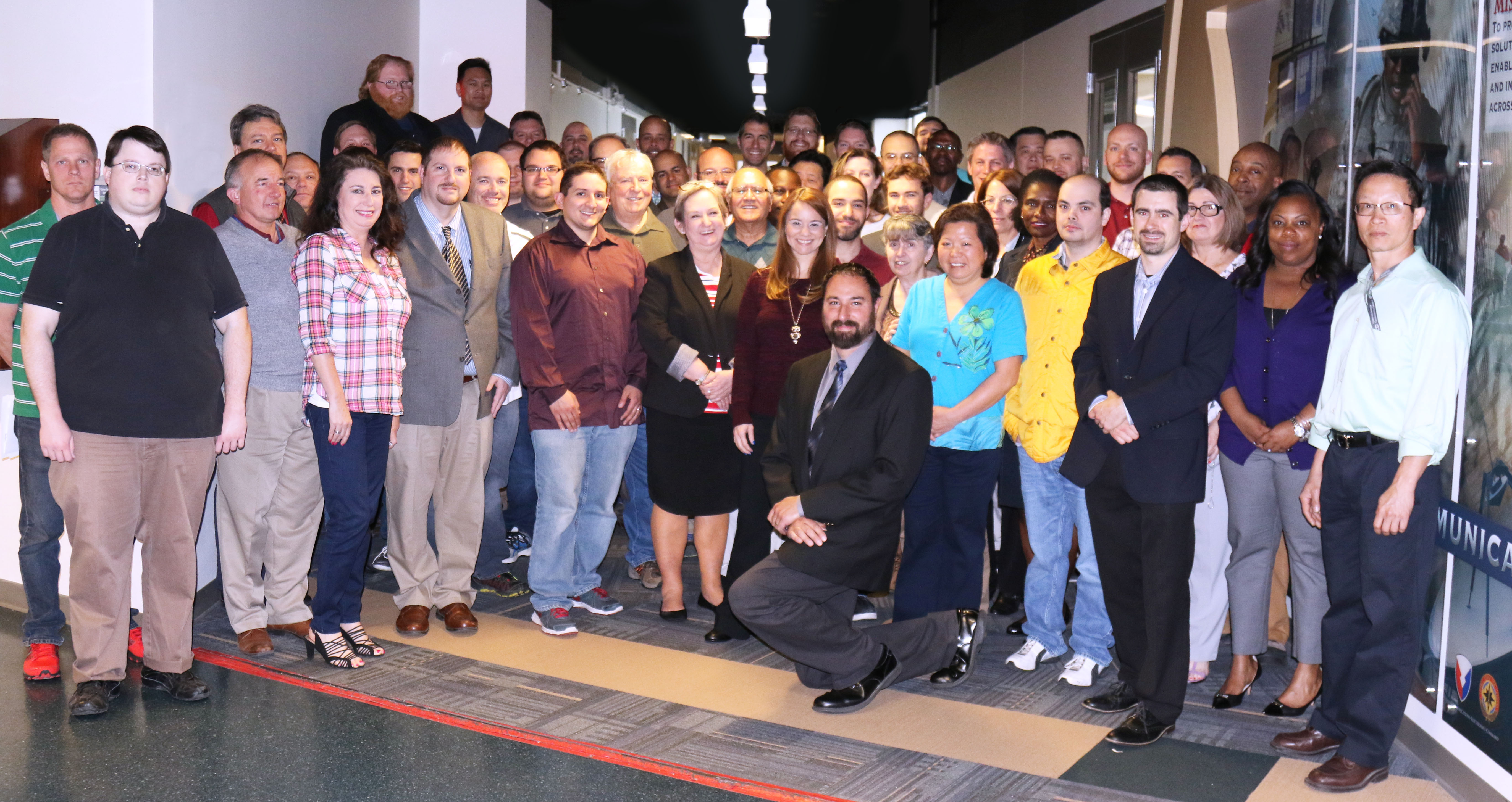
COMMAND/ORGANIZATION: U.S. Army Communications-Electronics Research, Development and Engineering Center (CERDEC), U.S. Army Research, Development and Engineering Command
TITLE: Chief, Cryptographic Modernization Branch
YEARS OF SERVICE IN WORKFORCE: 12
DAWIA CERTIFICATIONS: Level III in engineering
EDUCATION: M.S. in systems engineering, Stevens Institute of Technology; B.S. in electrical engineering, New Jersey Institute of Technology
AWARDS: Army Acquisition Executive’s Excellence in Leadership Science and Technology Professional of the Year; CERDEC Supervisor of the Quarter; Dr. William A. Novick Award
As chief of the Cryptographic Modernization Branch of the U.S. Army Communications-Electronics Research, Development and Engineering Center (CERDEC), Matthew Lazzaro finds himself on a front line of a different sort. “In this age of increasing cyberattacks and penetration attempts on the U.S. government, encryption equipment is the first line of defense for protecting our nation’s most critical infrastructure,” he explained.
Lazzaro, whose branch is part of the Space and Terrestrial Communication Directorate, oversees 17 subject matter experts and 52 contractor engineers and engineering technicians, tasked with planning and directing programs involving cryptographic encryption devices integral to national security. He gets a lot of satisfaction from being part of the development cycle—“working in the same field and witnessing, as well as taking part in, the evolution of the Army network from working legacy circuits that ran at 50 bits per second to backbone and encryptors reaching 100 gigabytes per second.”
He said the most important points of his career “have been working the entire life cycle of various encryption products, from initial test and evaluation, to fielding support, to the evolution of the product through software updates, and finally removing the product from the field and replacing it with new technology.”
The biggest challenge Lazzaro faces is part financial, part inability to predict the future: “Budgeting and proposing solutions for gaps that we don’t even know exist” is difficult, he said. “It’s hard to predict gaps and propose solutions for those gaps years in advance. My engineers regularly speak with program managers and field users to better assess needs so we can attack those larger gaps.”

CERDEC’s Cryptographic Modernization Branch team, led by Lazzaro, center, comprises some 70 experts, engineers and technicians. Together they are responsible for updating encryption equipment at Army installations worldwide to ensure continuous protection of military data. (Photo by Dan Baldwin, CERDEC)
His leadership of those efforts was among the reasons he received the award for the Army Acquisition Executive’s Excellence in Leadership Science and Technology Professional of the Year in 2016. Lazzaro garnered recognition for CERDEC’s support of the Project Management Office for Network Enablers (PMO Net E) within the Program Executive Office for Command, Control and Communications – Tactical. He was a key player in the Army-Wide Cryptographic Network Standardization (ACNS) initiative, led by PMO Net E, providing oversight, guidance and assistance to a team of engineers that modernized the entire Army inventory of cryptographic devices by replacing inactive ones with modern versions. He and his team removed nearly 5,400 legacy devices and installed more than 1,800 modern counterparts at 245 military bases worldwide.
The Army launched ACNS in 2012 to upgrade outmoded cryptographic devices and to standardize security capabilities for the Army’s tactical network. The ACNS team has received several accolades for its work to ensure that U.S. troops have cryptographic capabilities that protect data and voice transmission from electronic attack, including CERDEC’s Dr. William A. Novick Award for expediting technology to get it into the hands of Soldiers.
Lazzaro also was instrumental in CERDEC efforts to support the National Security Agency (NSA) Commercial Solutions for Classified (CSFC) Program, which provides a framework to reduce the logistical footprint and boost protection for transmitting and exchanging classified information. NSA created the program to facilitate the use of commercial products to protect classified national security systems information, and to bring cryptographic equipment into compliance with the agency’s standards for upgraded data networks and cryptographic algorithms and keys.
Thanks in part to Lazzaro’s contributions, CERDEC was the first DOD entity to earn the NSA certification of CSFC trusted system integrator. His lab has engineered or evaluated more than a dozen solutions that focus on reducing risk in the area of command, control, communications, computers, intelligence, surveillance and reconnaissance. In late 2015, the team provided a risk-reduction solution based on CSFC virtual private network capabilities for the Product Manager for Warfighter Information Network – Tactical. In just four weeks, it was able to engineer, integrate, test and validate the solution, which the Army successfully demonstrated at the Network Integration Evaluation 15.2 and has since integrated into future baselines for the project.
Receiving the Science and Technology Professional of the Year award caught Lazzaro off guard. “I sometimes forget that what we do—test and evaluation, integration, getting products into the hands of Soldiers—is considered acquisition,” he said. “Working at the forefront of protecting our nation’s most critical infrastructure is very satisfying.”
Lazzaro worked in the private sector for several years, in application engineering, motion-control system design, robotics and vision systems before joining the Army Acquisition Workforce. “I worked on a broad range of industrial applications,” he said, including for the U.S. Post Office, Benjamin Moore & Co. and Veeco Instruments Inc.’s semiconductor division. “Before that, I worked in fireplace design for many years.”
He was approached by engineers he knew through college friends to work in the field of information assurance (IA). It “sounded interesting, and it was a field I had worked in before, indirectly. It was something new and different and, at the time, it was a career track that colleges were not offering.” An opportunity arose to join CERDEC’s IA Division, working in the Cryptographic Modernization Program Management Office. “In that position, I was able to apply my engineering degree, testing and evaluating security equipment used on the government network.
The switch from the private sector to the public required a shift in mindset. “The government has a lot of rules, but a lot more resources,” he said. “In private industry, it was hard to get new technologies: We had to make do with what we had. In government, many resources are available, but there are a lot more acquisition and policy rules.”
Being in acquisition sort of snuck up on him, but he’s grateful to be part of the community. “As an engineer, I was looking to solve problems and work with new technology, and the positions I have held throughout my acquisition career have allowed me to do that.”
To anyone seeking similar opportunities, Lazzaro had this advice: Get out and work in the field or in the operational environment. “Nothing helps you learn as fast as trying to solve real-world problems as they are happening and getting your hands dirty. Working in the lab only gets you so far.”
This article will be published in the October – December 2017 Army AL&T magazine.
Subscribe to Army AL&T News, the premier online news source for the Acquisition, Logistics, and Technology (AL&T) Workforce.







